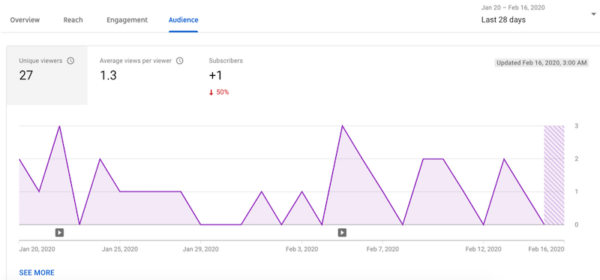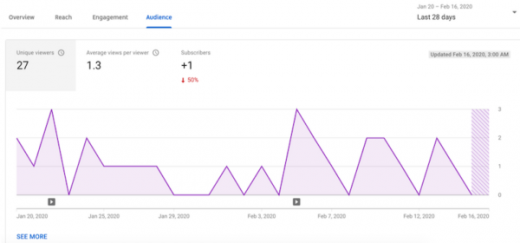31 Must-Know YouTube Statistics (+ Insights!) for 2020
You’re an in-house marketer on a mission to convince your manager that video content is the way to go. Or maybe you work at an agency and you’re trying to show a stubborn client that there’s a big, beautiful world beyond the Facebook news feed.
Or maybe you’re just curious as to how much content gets uploaded to YouTube every minute.

Via YouTube.
Motivations aside, everyone living in the year 2020 can benefit from a deep dive into YouTube statistics. So we’ve compiled nearly three dozen and broken them up into subcategories:
- General YouTube statistics
- YouTube demographic statistics
- YouTube marketing statistics
Accompanying each subcategory is two or three key takeaways. Let’s jump in!
General YouTube statistics
1. YouTube has over two billion monthly active users. (YouTube)
2. More than 70% of YouTube watch time is on mobile. (YouTube)
3. Over 100 countries have their own local version of YouTube. (YouTube)
4. 60% of people prefer online video to live TV. (Google)
5. YouTube is the world’s second-largest search engine. (Search Engine Journal)
6. YouTube is responsible for more than one-third of mobile internet traffic. (Statista)
7. 51% of YouTube users visit the site daily. (Pew Research Center)
8. 500 hours of content are uploaded to YouTube every minute. (Statista)
9. One billion hours of YouTube content are watched every day. (YouTube)
10. Relaxation and entertainment are the top reasons for watching YouTube videos. (Google)
11. This year, online video will account for 79% of internet traffic. (Cisco)
12. 75% of adults watch mobile YouTube videos while relaxing at home. (Google)
Key takeaways
Mobile, mobile, mobile. More than anything, that’s the word that stands out to me when I look over this first batch of stats. People watch a ton of YouTube content on their phones, and as stat #12 makes abundantly clear, it’s not an activity they do exclusively on the go. It’s time to part ways with the myth that consumers only use their phones when they’re commuting to work or standing in line for coffee. Believe it or not, your prospects are watching mobile YouTube videos while sitting on the couch and drinking white wine—entirely disinterested in moving an inch.
Here’s what that means: You need a full-funnel mobile strategy—one that takes advantage of everything YouTube has to offer. With 70% of watch time taking place on mobile and 51% of users returning to the site daily, it’s safe to assume that you have the power to reach prospects at all stages of the customer journey. With a six-second bumper ad, you can introduce yourself to a wide range of brand new prospects and drive awareness through the roof. Elsewhere, you can target a smaller (and more qualified) crop of users with a TrueView for Action campaign. The specifics will vary from business to business, but the takeaway for everyone is that YouTube attracts consumers from all stages of the funnel.

Elsewhere, please note stat #8 and stat #9: 500 hours of content are uploaded every minute, and one billion hours of content are watched every day. Being generic is simply not an option. Whether you plan to reach your audience through organic content or paid ads, it’s imperative that you try to do something that nobody else is doing. Don’t be so different that you confuse and/or turn your prospects off; just be different enough that you don’t fade into the background.
Before you hit record, all I ask is that you check out what your competitors are doing and make a concerted effort to do something different.
YouTube demographic statistics
13. Mobile YouTube videos reach more 18- to 19-year-olds than any TV network. (Google)
14. Among millennials, YouTube accounts for 67% of online video consumption. (Google)
15. Two-thirds of millennials say they can find how-to content for anything on YouTube. (Google)
16. 81% of US internet users between 15 and 25 years old use YouTube. (Statista)
17. YouTube reaches 89% of US households with over $ 100,000 in annual income. (Statista)
18. YouTube users are more likely to have kids than non-users. (Google)
19. YouTube users are more likely to have a bachelor’s degree than non-users. (Google)
20. During the average month, YouTube reaches 95% of internet users over 55. (Google)
Key takeaways
Evidently, YouTube users—especially those in their twenties and thirties—rely heavily on the platform to learn how to do things. For those of you interested in content marketing, this is an incredibly important insight. By creating educational YouTube videos related to your business, you can raise awareness and establish authority among your target audience. For example, if you were marketing an Italian restaurant, you could create how-to YouTube videos for different recipes. It’s safe to assume that anyone who YouTube searches “how to make gnocchi” would be interested in learning more about your restaurant!

Bartending videos are a great way to raise awareness of your bar!
Here’s the other key takeaway from this set of stats: YouTube isn’t just for young people. Even if your target audience is on the older side (e.g., baby boomers), you can still get a tremendous amount of value out of the platform—both from content marketing and paid advertising. Plus, YouTube is an especially valuable channel if you’re targeting parents, college graduates, individuals with high salaries, or some combination thereof. At the risk of beating a dead horse, I want to reiterate one more time: YouTube marketing is worthwhile for all kinds of businesses—not just businesses targeting teenagers and young adults.
My advice? Use organic content marketing to attract new eyeballs and use paid advertising to retarget those eyeballs. This doesn’t have to be rocket science. As the data shows, YouTube users get a ton of value out of simple educational content. With the right videos, you can bring hundreds—potentially thousands—of new prospects to the top of your marketing funnel. From there, paid campaigns like TrueView for Action can work their magic.
YouTube marketing statistics
21. Among businesses, YouTube is the second-most popular place to post videos. (Buffer)
22. YouTube is the third-most popular platform for influencer marketing content. (Mediakix)
23. Two-thirds of shoppers cite video as a source of purchase inspiration … (Google)
24. … and 90% of those shoppers have discovered something new through YouTube. (Google)
25. Nearly half of marketers are investing in YouTube advertising. (Hanapin)
26. A mobile YouTube ad is 84% more likely to engage prospects than a TV ad. (Ipsos)
27. Since 2016, YouTube users have watched over 50,000 years of product reviews. (Google)
28. YouTube users are 3X more likely to watch a tutorial than read instructions. (Google)
29. 80% of shoppers who used video for purchase inspiration say they did so at the beginning of the customer journey. (Google)
30. Since 2016, the number of SMBs advertising on YouTube has doubled. (YouTube)
31. Among digital channels, YouTube has the second-most influence on purchases. (Statista)
Key takeaways
There’s a lot to unpack here. Let’s start at the top with stat #21: Among businesses, YouTube is the second-most popular place to post videos. Facebook, unsurprisingly, still reigns supreme. To get the best results, I recommend sharing content across both platforms. As I shared in a recent post about Facebook video views, however, Facebook frowns upon content creators who repurpose videos originally published on other platforms. In other words, simply taking your YouTube content and sharing it on Facebook isn’t the best idea.
Here’s my advice: Dig into your audience data. Although it seems as if everyone with an internet connection uses both YouTube and Facebook, there’s a good chance that you attract a unique audience on each platform. By digging into the data, you can see which kind of content does best on YouTube and which kind of content does best on Facebook. If you can optimize your content on each of the world’s biggest video-sharing platforms, you’ll attract a steady stream of qualified prospects.

YouTube Studio offers plenty of helpful audience insights.
Next: A mobile YouTube ad is 84% more likely to engage prospects than a TV ad. Why? Because people use TV commercial breaks to scroll through social media and search stuff on Google. Therefore, I recommend reinforcing the messaging of your YouTube ads with your Facebook and Google ads. That way, even when your prospects opt for TV instead of YouTube, you can communicate the value of your product and keep your brand top-of-mind.
Finally: Product review content is a legitimate phenomenon. Although it’s completely unethical to pay YouTubers to review your product, you can still get in on the action. I suggest regularly searching YouTube for reviews of your product and responding to each and every one. Whether the review is positive or negative, it’s imperative that you leave a thoughtful response in the comment section. First and foremost, this demonstrates that you take customer feedback seriously. Plus, while responding to positive reviews gives other users an incentive to make review videos of their own, responding to negative reviews shows that you’re committed to holding your business accountable.
Digital & Social Articles on Business 2 Community
(29)


